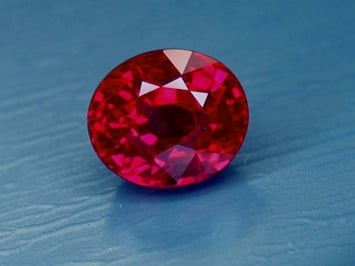What’s the Difference Between Rubies and Pink Sapphires?
How do gemologists distinguish between rubies and pink sapphires? Learn about the chemistry of corundum and the history of the color pink.
2 Minute Read
Defining Ruby and Sapphire
Scientifically, rubies and sapphires are simply varieties of corundum, a crystalline form of aluminum oxide (Al2O3), with impurities or trace elements such as iron, titanium, or chromium. These impurities create the wide range of colors found in corundum crystals: gray, brown, yellow, green, blue, purple, red, … and pink.
Ruby is defined as red corundum. The presence of chromium is largely what makes a corundum gemstone red. All other varieties of corundum, anything not red, are classified as sapphire. (Sapphires may contain a mix of chromium, titanium, and iron traces). Although popularly associated with the color blue, sapphires include all non-red colored corundum gems. It's not surprising, then, that pink is the boundary line between rubies and sapphires since pink is commonly considered a light tone of red.
Interested in this topic?
This article is also a part of our Ruby Specialist Mini Course, in the unit Introduction to Ruby.
Describing Color Involves Both Objective and Subjective Terms
Color can be quantified scientifically in terms of hue, tone or lightness, and saturation or intensity. Recently, advances in colorimeters have also addressed the unique problems gemstone optical qualities, such as pleochroism and transparency, have posed to standard color-order systems.
So why is there no general agreement on the difference between rubies and pink sapphires?
Although you can measure color, what one chooses to call a particular set of color measurements is still largely subjective. It comes down to the cultural and historical question: what is pink? In a fascinating article, Richard Hughes observes that before the 20th century, pink was considered a "light red" and some rubies were indeed described as "pink rubies." Over the course of the 20th century, "someone decided that pink was not red," and the first references to pink sapphires appeared.
How Do Professional Gemologists Distinguish Rubies and Pink Sapphires?
Professional gemology associations differ over the distinction between rubies and pink sapphires. Although the Gemological Institute of America (GIA) acknowledges historical and cultural variations on the division (or lack thereof) between red and pink color, it classifies as rubies only those corundum gems with "dominant" red hue. All other corundum is sapphire. On the other hand, the International Colored Gemstone Association (ICA) considers any red corundum gemstone, regardless of depth or intensity, a ruby.
The International Gem Society (IGS) acknowledges no general agreement on the difference between rubies and pink sapphires and has information on both "pinkish" rubies as well as pink sapphires.
Will the Demand for Pink Sapphires Change How We Distinguish These Gems?
Jewelry enthusiasts have highly prized sapphires throughout history. However, the demand for "blood red" rubies has been and continues to be exceptional. Gem-quality rubies are rare, much rarer than diamonds. The desire to find, cut, sell, and own rubies has created a demand for a restrictive definition. This may account in part for the rise of the "pink sapphire" category. This may be why buyers want to buy sapphires and sellers want to sell rubies.
However, the consumer demand for pink sapphires has recently increased, according to David Federman (who also challenges the argument that pink and red were ever considered the same color). "Today, pink sapphire needs no favors or apologies," and "hot pink" sapphires are in demand, he writes.
Could an increasing demand for pink gems change the boundary between rubies and pink sapphires? Only time and the market can tell.
International Gem Society
Related Articles
Sapphire Value, Price, and Jewelry Information
Ruby Gemstone Value, Price & Jewelry Insights
Corundum Value, Price, and Jewelry Information
Should I Make an Investment in Bargain Rubies?
Latest Articles
800 Years of Mogok: A Celebration in Tenuous Times
What is the Average Gemstone Faceting Yield?
Pyroxmangite Value, Price, and Jewelry Information
How to Identify Emerald Simulants and Synthetics
Never Stop Learning
When you join the IGS community, you get trusted diamond & gemstone information when you need it.
Get Gemology Insights
Get started with the International Gem Society’s free guide to gemstone identification. Join our weekly newsletter & get a free copy of the Gem ID Checklist!
